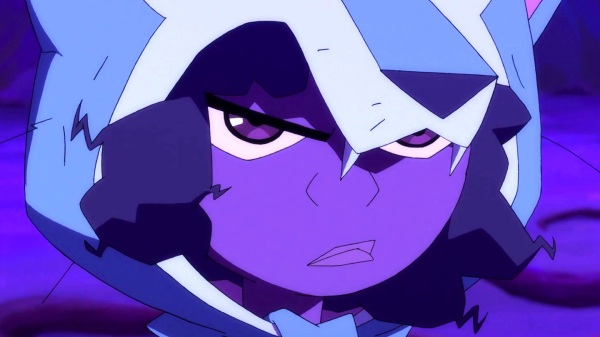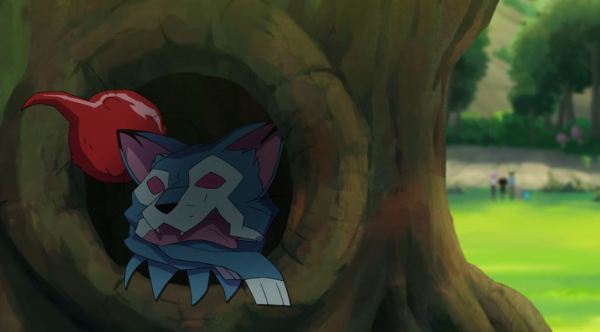Before I became the massive weeb I am today, I was first drawn to anime not out of an interest in Japan specifically, but out of love for the unique storytelling power of animation. Now’s a great time to be an animation fan, as popular interest in the medium’s potential grows alongside advances in technology and accessibility that allow for more diverse and ambitious cartoons worldwide.
And yet, I still don’t watch as much domestic animation as I probably should for one simple reason—most of it is aimed at children and families. Don’t get me wrong, I’ve enjoyed great kids’ shows like Gravity Falls and Steven Universe as an adult, two drops in a big bucket of quality children’s programming that’s more clever and thoughtful today than ever before, so I’m not blaming my lack of interest on any lack of complexity out there. Most family cartoons today are bound to be more edifying than the pile of brain-dead anime comedies I’ve binged for no good goddamn reason, and Kipo and the Age of Wonderbeasts is a perfect example.

I would’ve been obsessed with a show like this if it aired when I was as a kid. Post-apocalyptic adventure in wild pastels, a universe bursting with creative creatures where knowledge and communication always saves the day, a music-loving cast primed to break out into a diverse array of catchy tunes (my personal favorite was the Wu-Tang-flavored “Newton Wolves Rap”, co-written by GZA himself)—there’s a little bit of everything to love in Kipo and the Age of Wonderbeasts. The series also sports impressive racial diversity in its casting, and not just for token cameos halfway down its credit list. The core four heroes are all played by POC, and the most important male character, Benson, is gay, which we learn in an extremely charming and affirming scene early on in the series. No matter your age, it’s easy to get swept up in Kipo’s relentlessly positive creative energy, as she and her new friends band together to search for her lost people, secretly hiding in a burrow beneath a world that’s been re-populated by Warriors-esque gangs of super-evolved animals who dislike humans only slightly more than they distrust the other critter cliques.
But by the end of season one, all that positivity and creativity was starting to wash me out with its brightness, and I began to wonder if a younger Jacob wouldn’t have started to feel alienated from it as well. The dissonance between Kipo’s perspective and my own life experiences reminded me all too often that this was a show aimed at not just children, but a kind of child that I had never been. I was starting to feel like a wolf in sheep’s clothing watching along—or maybe a human in wolf’s clothing, just like the only character in the core four I related to: Wolf.

Sadly, I think my real stumbling block when it comes to enjoying family shows is their omnipresent focus on family itself. I don’t have children of my own to share these stories with, and my relationship with my own kin is too troubled for me to find warm, marketable messages about functional families relatable. Even in anime aimed at children, mom’s usually dead and dad’s often evil—it’s edgy and over the top, but it does feel closer to my own experiences than the idyllic relationship with her father that heavily informs Kipo’s character. Professor Lio Oak is hyper-capable, eternally good-natured, and flawlessly supportive of his precocious daughter. It’s even made explicit by several other characters that Kipo’s wunderkind ability to bring every species of Wonderbeast together in pursuit of world peace comes from her privileged upbringing, where “can’t” was never an option. Despite growing up underground and losing her mother in infancy, boredom seems to be the only thing Kipo really struggled with before coming to the surface.
Things were very different for Wolf, a four-foot-nothing string bean with a bad attitude who was raised by mutated wolves on a surface that’s grown hostile to humans. We don’t learn more about her upbringing until near the end of the season, but it’s easy to assume the worst, since Wolf wears the child-sized hide of a fellow pup everywhere she goes. That wolf-skin’s vacant mauve eye-holes remain a jarring visual in an otherwise optimistic story, which gave me the impression that this series was going to have a more complicated perspective on its Wonderbeast apocalypse than it ended up having.

The season does start out by making overtures toward a push and pull between Kipo’s “trust everyone” and Wolf’s “trust no one” dichotomy, but Kipo’s faith in the best intentions of beastkind is consistently rewarded, while Wolf must gradually learn to connect with others and accept what it means to be part of a family. She does protect Kipo at times with her honed survivor skills, but by the end of any given episode, Wolf’s self-preservation tactics are never a better solution than Kipo’s open-hearted diplomacy. Kipo’s childhood built on love and affirmation has ironically prepared her for life in the apocalypse better than Wolf’s childhood of manipulation and abandonment, so Wolf is the one who has to do all the growing, while her once-dark world slowly molds to Kipo’s bright ideals.
Look, it’s a good message for kids. It makes more sense to build a family-friendly theme of unity and communication around the idea that no one really has any enemies, and all barriers of tribalism can be broken down with enough honest effort. Apocalypse aside, Kipo and the Age of Wonderbeasts does technically take place in the future. I would love to believe that we’re moving toward a world where no child has to find a safe way to live around enemies who cannot be reasoned with—but that’s not the world I was raised in, and it’s not the world Wolf was raised in either. After a shocking reveal pushes Wolf away from Kipo late in the season, we finally get a glimpse of her early years, where an ascetic wolf couple raised her alongside their pups to train them in hunting humans. Wolf believed she was part of the pack right up until the betrayal, so when Benson tries to convince her that Kipo is her sister now, and you can’t fake family, Wolf responds with stone-cold confidence: “You’re wrong. You can fake it.”

The conversation ends there, swept to the side by an action scene where Kipo does indeed return to save Wolf from a different pack of wolves, and all is forgiven. Kipo and the Age of Wonderbeasts doesn’t offer any other answer for Wolf’s formative encounter with unshakable bad faith and heinous lies told to sustain tribal supremacy, because that’s the only example of it we ever see in Kipo’s world. Everyone else in the series, even the maybe-evil mastermind mandrill Scarlamagne, speaks and acts with such overwhelming emotional honesty that you can’t imagine calling them evil. I guess you could call Scarlamagne evil, as Kipo does, for wanting to kidnap and control human beings, but when the finale reveals that Kipo’s dad probably created Scarlamagne in a lab somewhere, it’s easy to assume that this is all some kind of interpersonal misunderstanding instead. Good or evil, there’s a bigger villain out there somewhere, so Scarlamagne almost feels as though he’s not meant to be taken seriously at all.
There’s also the aptly named Mulholland, a massive tardigrade who shows his victims their most beautiful fantasies while his water bear agents consume their brains. Somehow, Mulholland is unaware that his victims don’t enjoy being absorbed down to the bones until Wolf tells him explicitly, and he decides that going on a road trip of self-examination should be apology enough for the slow liquefication of so many sentient beings. And then there’s Jamack, a Mod Frog whose life gets dramatically ruined when his fellow amphibians disown him for failing to catch Kipo too many times. After he finally gets his webbed mitts on our heroine again, he decides to not only let her go, sacrificing a lifetime of riches and power alongside Scarlamagne, he even goes out of his way to rescue her from competing gangs. Kipo did save Jamack from getting eaten once, but he’d already confidently re-kidnapped her a few times since then. His only explanation for risking such a dangerous face-turn comes in the form of a warning.

It seems like Jamack ultimately decided that Kipo was a “good guy,” and if he didn’t want to be a “bad guy”, he had to let her go. He wasn’t won over by anything Kipo did for him specifically, and it costs him greatly to give her up, but if you’re righteous and kind enough, even a Mod Frog will want to act in good faith toward you. So if Kipo’s tactics always work, then Jamack’s warning feels weightless. Helping and talking does solve every problem in season one, even in a world full of feuding monsters who accept “live and let live” surprisingly fast after centuries of “survival of the fittest”.
Wolf’s clothing is one of the show’s only unsettling reminders of bad faith, failure, betrayal, and even death in the world, so it’s no wonder that her more fun-loving friends encourage her to leave it behind. Stories about damaged survivors and loners finally finding a safe place to belong are slam-dunk heartwarming, and I have no problem with the idealistic world Kipo and the Age of Wonderbeasts has chosen to show kids, especially when it’s told with so much talent and enthusiasm. But I’m afraid I don’t believe there’s an Age of Wonderbeasts ahead of us, and I can’t blame kids like Wolf for clinging to their dark security blankets no matter how many Kipos and Bensons try to soften them with their best intentions—it’s not that Wolf doesn’t believe in a better world, but the way she survived the world she’s got has made her who she is. Now she’s found herself in a story where Kipo, a character who’s never known trauma or hardship, effortlessly undercuts all the darkness in her path with songs and sunshine.

By the end of the first season, Kipo discovers that she has mutant jaguar superpowers, which makes total sense for her character as the bridge between the human and animal worlds, but it also worries me for the future direction of the show’s message. As if her spirit wasn’t overpowered enough, making Kipo physically stronger than everyone else gives her an even more unrelatable advantage against any truly evil opponents acting in bad faith. Now she can just dominate anyone that she couldn’t win over, wielding the same mantras of peace, love, and understanding with the long paw of the law. It’s much easier to be kind when you wield power, and I can only hope Wolf isn’t expected to rise to the same rose-colored standards as her sister, not while she’s still bearing the weight of that wolf on her back.
Thanks to Corey for commissioning this review. You can commission my work on Ko-Fi here! Thank you for your support. ❤

I’d been curious about this show (cause Netflix keeps shoving it in my face), so I’m glad to finally hear someone talk about it. Doesn’t sound like my cup of tea, either.
Have you seen She-ra? It lags in places, but overall it felt like everything I liked about Sailor Moon but better. And flashier. And gayer.
I’d also be very curious to hear your thoughts on Steven Universe Future because that show.
LikeLike